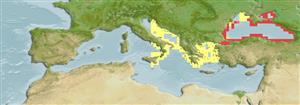Classification / Names
Common names from other countries
Main reference
Size / Weight / Age
Max length : 200 cm TL male/unsexed; (Ref. 3397); common length : 132 cm TL male/unsexed; (Ref. 3397); max. published weight: 80.0 kg (Ref. 52332)
Length at first maturity
Lm ? range ? - ? cm
Environment
Marine; freshwater; brackish; demersal; anadromous (Ref. 51243); depth range 30 - 60 m (Ref. 3397)
Climate / Range
Temperate; 10°C - 20°C (Ref. 2059), preferred ?; 57°N - 36°N, 14°E - 53°E
Distribution
Europe: Black, Azov, Caspian and Aral Sea, ascending some rivers (Danube up to Bratislava, Volga up to Kazan, Ural up to Chkalov), unknown or very rare in others. On the verge of extinction in its natural range. Extirpated in Aral basin; nearly extirpated in Black Sea basin; only occasional records from Danube and lower Volga; only a very small population remaining in Rivers Ural (Russia, Kazakhstan) and Rioni (Georgia); no natural spawning population in Iran; established in Lake Balkhash where it forms a large population (Ref. 59043). Artificially propagated (Ref. 6866). International trade restricted (CITES II, since 1.4.98; CMS Appendix II).
Countries | FAO areas | Ecosystems | Occurrences | Introductions
Short description
Dorsal
spines
(total): 0;
Dorsal
soft rays
(total): 45-57;
Anal
soft rays: 23 - 37. Snout moderately long and pointed at tip. Lower lip continuous, not interrupted at centre. Barbels halfway between tip of snout and mouth, reaching the latter. Five rows of scutes, dorsal 11-17, lateral 49-70, but usually 55-56 on each side, ventral 10-16, with no smaller plates between dorsal and ventral rows. Color of back grey, flanks lighter, belly white.
IUCN Red List Status (Ref. 115185)
Threat to humans
Harmless
Human uses
Fisheries: commercial; aquaculture: commercial
More information
ReferencesAquacultureAquaculture profileStrainsGeneticsAllele frequenciesHeritabilityDiseasesProcessingMass conversion
Tools
Special reports
Download XML
Internet sources
Estimates of some properties based on models
Phylogenetic diversity index
PD50 = 0.5000 many relatives (e.g. carps) 0.5 - 2.0 few relatives (e.g. lungfishes)
Trophic Level
3.3 ±0.45 se; Based on food items.
Resilience
Low, minimum population doubling time 4.5 - 14 years (K=0.04-0.12; tmax=30; Fec=165,000)
Vulnerability
Very high vulnerability (85 of 100)
Price category
